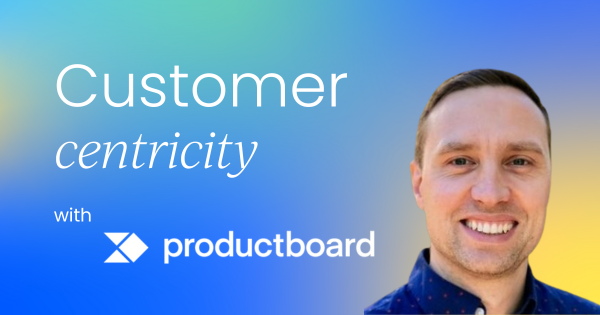Product operations has come a long way in just a few short years. Once considered an emerging role, it’s now firmly established in nearly every scaled product organization – with 96% of surveyed companies reporting some form of product ops function in place.
But as the State of Product Ops report 2025 reveals, the function is still maturing: only 7% of practitioners report high levels of automation, and one in five teams still lack a formal way to measure effectiveness.
This evolution sets the stage for next week’s Product Operations Summit in San Francisco, where I’ll lead a session emphasizing the importance of building customer-obsessed product teams.
It’s a timely conversation: how can leaders ensure that product ops isn’t just present, but truly embedded into decision-making at scale?
From proving value to embedding influence
At Productboard, we believe the challenge is no longer proving product ops' value – it's fully embedding the function into cross-functional decision-making. But here's what we've learned: even the most sophisticated processes fail if teams fundamentally misunderstand who they're building for.
Recent data shows that almost half of product ops teams now report directly to a Chief Product Officer, underlining how closely the function is tied to top-level strategy. But embedding influence isn't just about reporting lines – it's about ensuring teams truly understand their customers, not just assume they do.
The most practical step for product ops teams is to make customer insights visible at the exact moment product decisions are being made. Too often, insights live in research decks or CRM notes, disconnected from daily workflows.
Teams should link every feature idea, prioritization discussion, and roadmap decision back to actual customer needs, pain points, and data.
This creates a discipline where product managers aren't just asking, "What do we build?" but instead, "Who are we building this for, what problem are we solving, and how do we know?"
That small shift – from abstract strategy to lived customer evidence – completely changes the quality of decisions.
Operationalizing customer-centricity
Too many teams still struggle to connect the dots between customer feedback and the decisions that matter most. Insights are gathered, but they don’t always make their way into prioritization or roadmaps.
In fact, survey data shows that while more than half of product ops practitioners are responsible for aggregating customer feedback, feedback tools themselves are often ranked among the least valuable in their stack.
That disconnect is exactly the challenge we’ve focused on at Productboard: bridging the gap between scattered customer signals and the product decisions that matter.
It helps teams centralize feedback from sales, support, research, and customer interviews, and then connects that feedback directly to features, roadmaps, and priorities.
This means that when teams debate trade-offs, they can see not just opinions, but concrete evidence of how many customers asked for something, which personas are affected, and what business outcomes it supports.
By making customer evidence unavoidable in prioritization discussions and roadmap debates, product ops leaders can transform “customer-centricity” from a slogan into a system.
In short, Productboard operationalizes customer-centricity – making it systematic, not aspirational.
Customer-centricity as the daily operating system
Customer-centricity can’t be a once-a-quarter exercise; it has to be the daily operating system of a product team.
Otherwise, you risk moving fast in the wrong direction – optimizing for efficiency while missing what customers actually value.
That mindset shift is critical for product ops leaders who want to shape not just process, but impact. The key is to make customer insights unavoidable: build processes, rituals, and tools so that every roadmap discussion, prioritization meeting, or feature spec is grounded in customer evidence.
Encouragingly, this type of integration is already happening in many organizations: over three-quarters of product managers actively engage with product ops processes. Still, there are gaps – with one in five teams reporting that fewer than half of PMs participate.
That inconsistency underscores exactly what we’re calling for: systems and rituals that make engagement with customer evidence the default, not an optional extra.
In other words, true customer-obsession isn’t about motivational posters or lofty strategy documents. It’s about designing operating systems where the easiest path is also the most customer-centric one.
By structuring workflows so that evidence is front and center, product ops ensures that speed never comes at the expense of relevance – and that product teams are consistently solving the right problems for the right people.
Looking ahead: AI as the inflection point
When asked about the future, I can’t help but point to AI and automation.
The biggest trend will be the infusion of AI into product operations – helping teams not just collect and store customer data, but truly make sense of it at scale.
Product ops will become the function that enables insight-driven decisions at speed:
- Synthesizing thousands of feedback points into patterns,
- Surfacing unmet needs automatically, and
- Guiding prioritization with evidence rather than anecdotes.
Industry data suggests we’re at the very beginning of this shift. Nearly half of practitioners believe AI will reshape product ops within three years, and 62% of teams already use it to automate repetitive tasks.
But the bigger prize is still ahead: applying AI not just to automate tasks, but to uncover patterns in customer needs and translate them into better product decisions.
As the volume of customer input grows, the real differentiator will be how effectively product ops pros can turn those insights into clarity and confidence for product teams.
AI will make that possible, but only if product ops leaders build the right frameworks to channel it.
It's not too late to join Productboard in San Francisco
Next week, at the Product Operations Summit in San Francisco, attendees will hear firsthand how leading teams have turned these principles into practice.
My session, "It's all about the customer," will showcase the fundamental challenge facing product teams today: while we've optimized for speed and efficiency, we've often lost sight of truly understanding the people we serve.
I'll explore strategies and examples of organizations that have successfully embedded customer-centricity into their everyday product practices – not just as a slogan, but as their operating system.
For product ops leaders, the message is clear: the future of the function lies in turning overwhelming amounts of customer input into clarity, confidence, and strategy. In a world obsessed with velocity, the real differentiator is ensuring speed never comes at the expense of genuine customer understanding.
And those who can operationalize customer-centricity today will be the ones shaping product excellence tomorrow.



 Follow us on LinkedIn
Follow us on LinkedIn




